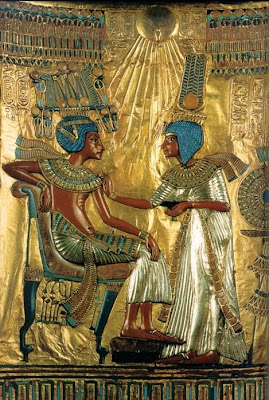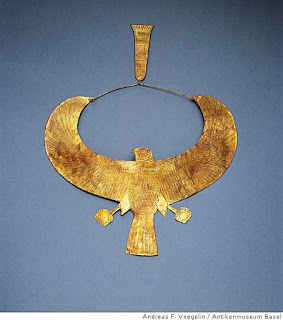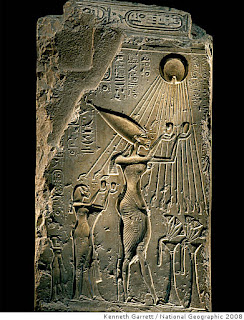 One of the strengths of this exhibit is its inclusion of objects from the family, friends and court of Amarna and Tutankhamen. While the golden mask remains in Cairo, being too fragile to travel, the other items give a more comprehensive look at this fascinating period in Egyptian history.
One of the strengths of this exhibit is its inclusion of objects from the family, friends and court of Amarna and Tutankhamen. While the golden mask remains in Cairo, being too fragile to travel, the other items give a more comprehensive look at this fascinating period in Egyptian history.When I was a teenager, I read "The Lost Queen of Egypt." It was a fanciful (but in some ways) historically accurate recreation of the life of Ankhesenamen, the daughter of Akhenaten and Nefertiti and the wife of Tutankhamen. I loved this book, which was filled with exquisite line drawings based on the art of the Amarna period. Starting with her childhood, Lucile Morrison imagined Ankhesenamen's life in Amarna as a princess of the Royal Family and her dawning awareness of the treachery and intrigue surrounding her father. In the book, she is able to escape from the royal palace after Tutankhamen's death and live the life of a non-royal woman with her lover, an artist from Crete. Would that it were so - but her real life history is even more amazing.
Records were found in the Hittite archive outlining a strange sequence of events. In all the 3,000 years of Egyptian history, these letters are the only personal ones from a Queen of Egypt that have been found. After the death of Tutankhamen a queen referred to as Dahamunzu writes to King Suppiluliumas and asks him to send her one of his many sons to marry and become lord of the land of Egypt.
"He who was my husband is dead and I have no son. Should I then perhaps take one of my servants and make him my husband?"
King Suppiluliuma suspects some trick and sends one of his envoys to investigate. After some time the King decides to send his son, Prince Zannanza, to Egypt. The prince dies, possibly murdered, and the King expects foul play. Later, he declared war on Egypt. The last letters in the exchange show a correspondence between Aye and Suppiluliuma. All of Ankhesenamen's attempts to escape whatever fate was planned for her failed. We will never know her motives or why she even thought such a scheme could succeed.
There is some indication that she married Aye, who may have been her grandfather. Amarna family relationships were complex beyond belief with intermarriage carried to a new level, with father-daughter marriages as well as the more common brother-sister marriages. There may have even been a father-son marriage! The elderly Aye was pharaoh after Tutankhamen and a ring with their joint cartouches was found in Aye's tomb. But after that, silence. She disappears from history, her ultimate fate a mystery.
But I love to think that there was true love between her and Tutankhamen and that the numerous images of her in Tutankhamen's funeral goods are not there for solely religious reasons. The four statues of the golden goddesses who guarded his canopic chest are all portraits of the queen. They are shown together in various scenes on the shrines, the chests for clothing. She is languidly handing him as arrow as he hunts along the Nile. She waits upon his pleasure, sitting on the floor beside him, her arm resting on his knee, anointing him with perfume, both of them wrapped up in each other.
The Flower Song (Excerpt)
To hear your voice is pomegranate wine to me:
I draw life from hearing it.
Could I see you with every glance,
It would be better for me
Than to eat or to drink.
(Translated by M.V. Fox)
To hear your voice is pomegranate wine to me:
I draw life from hearing it.
Could I see you with every glance,
It would be better for me
Than to eat or to drink.
(Translated by M.V. Fox)
 When Howard Carter discovered the tomb of Tutankhamen, several items showed the image of Tutankhamen's Queen. One of the most famous objects is the golden throne, which shows Ankhesenamen standing before her husband. She is apparently anointing the king. Ankhesenamen is shown wearing a short Nubian wig and her regalia consist of a modius consisting of uraei topped with the horned sun disk and the double plumes. The sun disk and plumes associate her with the goddess Hathor. Above them shines the sun disk of the Aton, its rays ending in hands as they bless the royal pair.
When Howard Carter discovered the tomb of Tutankhamen, several items showed the image of Tutankhamen's Queen. One of the most famous objects is the golden throne, which shows Ankhesenamen standing before her husband. She is apparently anointing the king. Ankhesenamen is shown wearing a short Nubian wig and her regalia consist of a modius consisting of uraei topped with the horned sun disk and the double plumes. The sun disk and plumes associate her with the goddess Hathor. Above them shines the sun disk of the Aton, its rays ending in hands as they bless the royal pair.I am thy wife, O great one -- do not leave me!
Is it thy good pleasure, O my brother that I should go far from thee!
But thou remain silent and speak not.
Is it thy good pleasure, O my brother that I should go far from thee!
But thou remain silent and speak not.



























